Project Management Challenges and Difficulties: A Case Study of Information System Development
VerifiedAdded on 2023/01/20
|16
|6250
|31
AI Summary
This article presents a case study on the challenges and difficulties faced in information system development projects. It discusses the critical issues such as fund, infrastructure, manpower, management commitment, monitoring, and inspection. The study recommends sufficient budget allocation and staff training for effective system development.
Contribute Materials
Your contribution can guide someone’s learning journey. Share your
documents today.
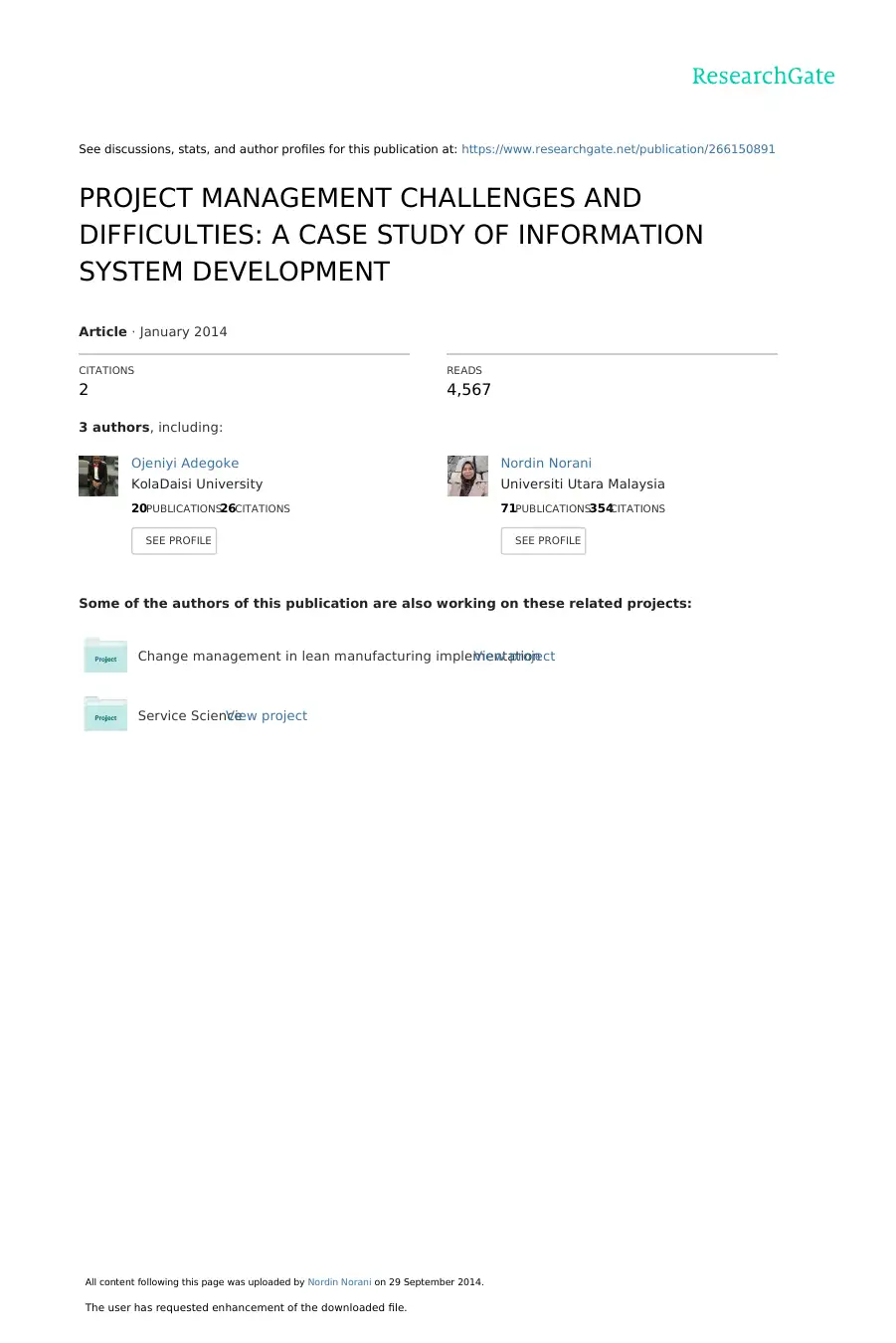
See discussions, stats, and author profiles for this publication at: https://www.researchgate.net/publication/266150891
PROJECT MANAGEMENT CHALLENGES AND
DIFFICULTIES: A CASE STUDY OF INFORMATION
SYSTEM DEVELOPMENT
Article · January 2014
CITATIONS
2
READS
4,567
3 authors, including:
Some of the authors of this publication are also working on these related projects:
Change management in lean manufacturing implementationView project
Service ScienceView project
Ojeniyi Adegoke
KolaDaisi University
20PUBLICATIONS26CITATIONS
SEE PROFILE
Nordin Norani
Universiti Utara Malaysia
71PUBLICATIONS354CITATIONS
SEE PROFILE
All content following this page was uploaded by Nordin Norani on 29 September 2014.
The user has requested enhancement of the downloaded file.
PROJECT MANAGEMENT CHALLENGES AND
DIFFICULTIES: A CASE STUDY OF INFORMATION
SYSTEM DEVELOPMENT
Article · January 2014
CITATIONS
2
READS
4,567
3 authors, including:
Some of the authors of this publication are also working on these related projects:
Change management in lean manufacturing implementationView project
Service ScienceView project
Ojeniyi Adegoke
KolaDaisi University
20PUBLICATIONS26CITATIONS
SEE PROFILE
Nordin Norani
Universiti Utara Malaysia
71PUBLICATIONS354CITATIONS
SEE PROFILE
All content following this page was uploaded by Nordin Norani on 29 September 2014.
The user has requested enhancement of the downloaded file.
Secure Best Marks with AI Grader
Need help grading? Try our AI Grader for instant feedback on your assignments.
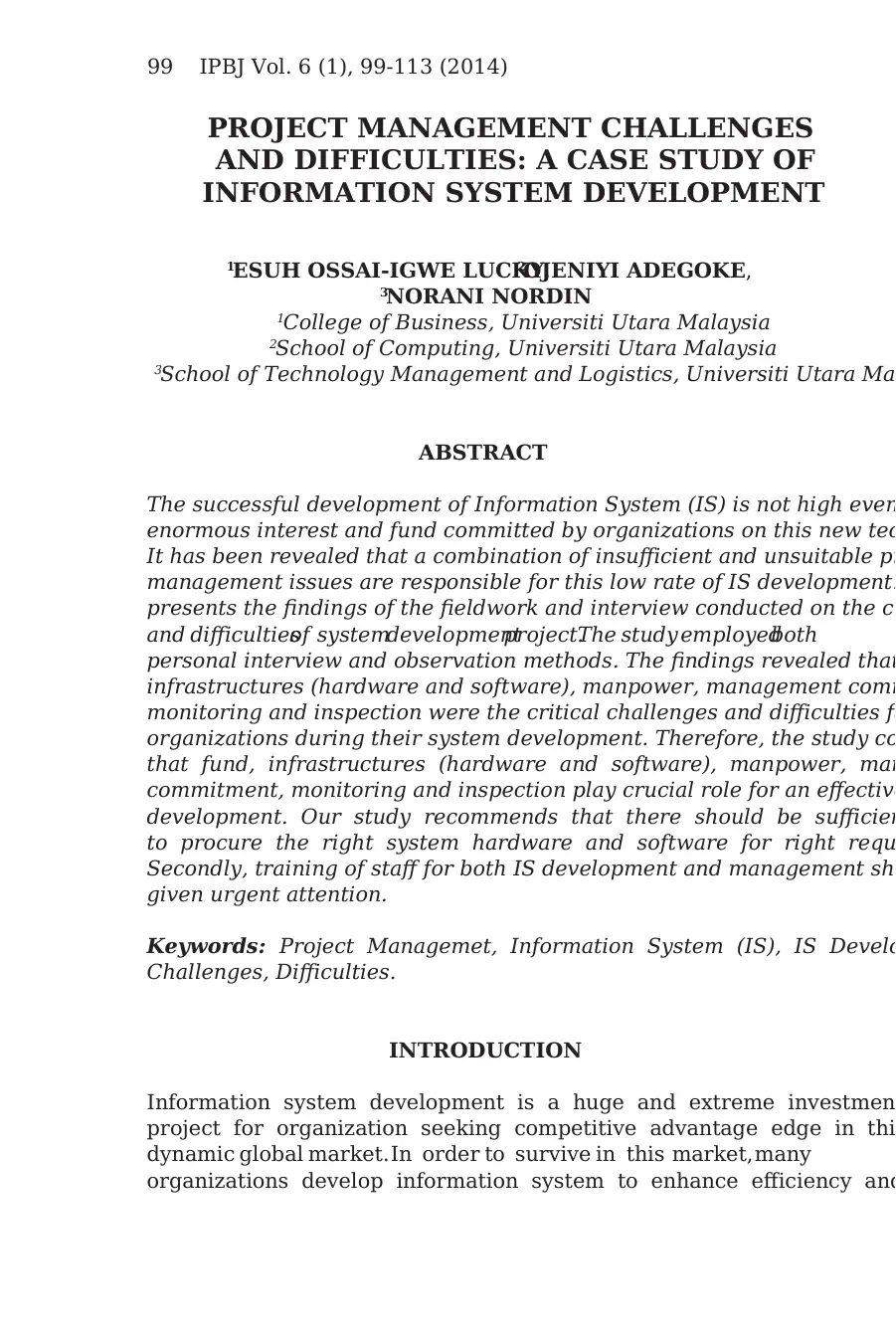
99 IPBJ Vol. 6 (1), 99-113 (2014)
PROJECT MANAGEMENT CHALLENGES
AND DIFFICULTIES: A CASE STUDY OF
INFORMATION SYSTEM DEVELOPMENT
1ESUH OSSAI-IGWE LUCKY,2OJENIYI ADEGOKE,
3NORANI NORDIN
1College of Business, Universiti Utara Malaysia
2School of Computing, Universiti Utara Malaysia
3School of Technology Management and Logistics, Universiti Utara Ma
ABSTRACT
The successful development of Information System (IS) is not high even
enormous interest and fund committed by organizations on this new tec
It has been revealed that a combination of insufficient and unsuitable pr
management issues are responsible for this low rate of IS development.
presents the findings of the fieldwork and interview conducted on the ch
and difficultiesof systemdevelopmentproject.The study employedboth
personal interview and observation methods. The findings revealed that
infrastructures (hardware and software), manpower, management comm
monitoring and inspection were the critical challenges and difficulties fa
organizations during their system development. Therefore, the study co
that fund, infrastructures (hardware and software), manpower, man
commitment, monitoring and inspection play crucial role for an effective
development. Our study recommends that there should be sufficien
to procure the right system hardware and software for right requ
Secondly, training of staff for both IS development and management sho
given urgent attention.
Keywords: Project Managemet, Information System (IS), IS Develo
Challenges, Difficulties.
INTRODUCTION
Information system development is a huge and extreme investmen
project for organization seeking competitive advantage edge in thi
dynamic global market. In order to survive in this market, many
organizations develop information system to enhance efficiency and
PROJECT MANAGEMENT CHALLENGES
AND DIFFICULTIES: A CASE STUDY OF
INFORMATION SYSTEM DEVELOPMENT
1ESUH OSSAI-IGWE LUCKY,2OJENIYI ADEGOKE,
3NORANI NORDIN
1College of Business, Universiti Utara Malaysia
2School of Computing, Universiti Utara Malaysia
3School of Technology Management and Logistics, Universiti Utara Ma
ABSTRACT
The successful development of Information System (IS) is not high even
enormous interest and fund committed by organizations on this new tec
It has been revealed that a combination of insufficient and unsuitable pr
management issues are responsible for this low rate of IS development.
presents the findings of the fieldwork and interview conducted on the ch
and difficultiesof systemdevelopmentproject.The study employedboth
personal interview and observation methods. The findings revealed that
infrastructures (hardware and software), manpower, management comm
monitoring and inspection were the critical challenges and difficulties fa
organizations during their system development. Therefore, the study co
that fund, infrastructures (hardware and software), manpower, man
commitment, monitoring and inspection play crucial role for an effective
development. Our study recommends that there should be sufficien
to procure the right system hardware and software for right requ
Secondly, training of staff for both IS development and management sho
given urgent attention.
Keywords: Project Managemet, Information System (IS), IS Develo
Challenges, Difficulties.
INTRODUCTION
Information system development is a huge and extreme investmen
project for organization seeking competitive advantage edge in thi
dynamic global market. In order to survive in this market, many
organizations develop information system to enhance efficiency and

100 IPBJ Vol. 6 (1), 99-113 (2014)
profitability. This usually makes organizations to commits considerable
time, resources and funds to information system development with the
expectation of receiving efficiency and profitability in return. However,
many organizations usually make the mistake of valuing technology
over the organization process (Drucker, 1998). This usually leads to
investment in technology that goes beyond their needs and resulting
to inefficiencyand wastefulness.Likewise, it might even result to
abandonment or failure of the development of the information system.
Information system on its own cannot create the gains and advantages that
organization need to survive the dynamic competitive global market. The
need to explore project management in information system development
becomes desirable to ensure successful and effective organization gains
and advantages in the global market. Hence the combination of project
managementand informationsystem developmentwill provide a
better philosophy and method for planning and managing successful IS
development.
Similarly, IS development is a project and success and failure of project
depends largely on the methodology adopted. Project management
methodology defined the step-by-step,quality standard, activities,
tools, controls, processes and deliverable elements to achieve successful
development of the project. Therefore, the success of IS development
project does not totally depends on the development team but more
on the set of processes and procedures in place to ensure successful
completion. Hence, it becomes necessary to investigate difficulties and
challengesexperiencewhile developmentinformationsystem from
project management perspective.
LITERATURE REVIEW
In today’s ever increasingly competitive markets, business and
enterprises rely more and more in their information systems to achieve
their purposes of effectiveness and efficiency. New technologies bring
new opportunities to enhance business operations and interactions.
Project management is concerned about the application of tools, skills,
knowledge and techniques to achieve effectiveness and efficiency to
survival in competitive market (PMI, 2000). The usefulness of project
management cut across disciplines and it’s applicable to any industry
regardless of the service and product it aims to achieve. Despite its wide
application in different industries and products, project management has
an enormous usefulness on effective development of IS to significantly
increase the successful completion.
profitability. This usually makes organizations to commits considerable
time, resources and funds to information system development with the
expectation of receiving efficiency and profitability in return. However,
many organizations usually make the mistake of valuing technology
over the organization process (Drucker, 1998). This usually leads to
investment in technology that goes beyond their needs and resulting
to inefficiencyand wastefulness.Likewise, it might even result to
abandonment or failure of the development of the information system.
Information system on its own cannot create the gains and advantages that
organization need to survive the dynamic competitive global market. The
need to explore project management in information system development
becomes desirable to ensure successful and effective organization gains
and advantages in the global market. Hence the combination of project
managementand informationsystem developmentwill provide a
better philosophy and method for planning and managing successful IS
development.
Similarly, IS development is a project and success and failure of project
depends largely on the methodology adopted. Project management
methodology defined the step-by-step,quality standard, activities,
tools, controls, processes and deliverable elements to achieve successful
development of the project. Therefore, the success of IS development
project does not totally depends on the development team but more
on the set of processes and procedures in place to ensure successful
completion. Hence, it becomes necessary to investigate difficulties and
challengesexperiencewhile developmentinformationsystem from
project management perspective.
LITERATURE REVIEW
In today’s ever increasingly competitive markets, business and
enterprises rely more and more in their information systems to achieve
their purposes of effectiveness and efficiency. New technologies bring
new opportunities to enhance business operations and interactions.
Project management is concerned about the application of tools, skills,
knowledge and techniques to achieve effectiveness and efficiency to
survival in competitive market (PMI, 2000). The usefulness of project
management cut across disciplines and it’s applicable to any industry
regardless of the service and product it aims to achieve. Despite its wide
application in different industries and products, project management has
an enormous usefulness on effective development of IS to significantly
increase the successful completion.
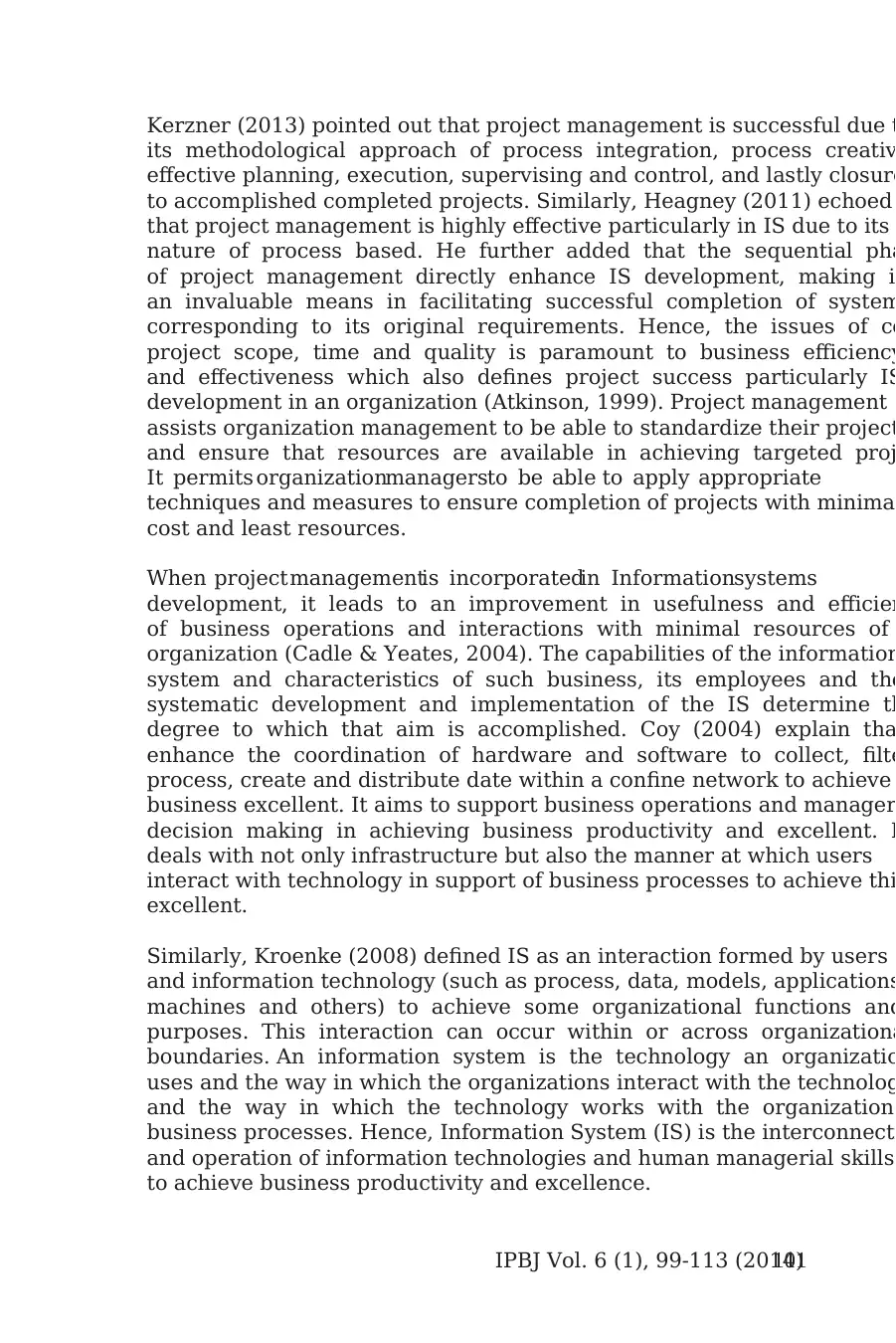
IPBJ Vol. 6 (1), 99-113 (2014)101
Kerzner (2013) pointed out that project management is successful due t
its methodological approach of process integration, process creativ
effective planning, execution, supervising and control, and lastly closure
to accomplished completed projects. Similarly, Heagney (2011) echoed
that project management is highly effective particularly in IS due to its
nature of process based. He further added that the sequential pha
of project management directly enhance IS development, making i
an invaluable means in facilitating successful completion of system
corresponding to its original requirements. Hence, the issues of co
project scope, time and quality is paramount to business efficiency
and effectiveness which also defines project success particularly IS
development in an organization (Atkinson, 1999). Project management
assists organization management to be able to standardize their project
and ensure that resources are available in achieving targeted proj
It permits organizationmanagersto be able to apply appropriate
techniques and measures to ensure completion of projects with minima
cost and least resources.
When project managementis incorporatedin Informationsystems
development, it leads to an improvement in usefulness and efficien
of business operations and interactions with minimal resources of
organization (Cadle & Yeates, 2004). The capabilities of the information
system and characteristics of such business, its employees and the
systematic development and implementation of the IS determine th
degree to which that aim is accomplished. Coy (2004) explain tha
enhance the coordination of hardware and software to collect, filte
process, create and distribute date within a confine network to achieve
business excellent. It aims to support business operations and manager
decision making in achieving business productivity and excellent. I
deals with not only infrastructure but also the manner at which users
interact with technology in support of business processes to achieve thi
excellent.
Similarly, Kroenke (2008) defined IS as an interaction formed by users
and information technology (such as process, data, models, applications
machines and others) to achieve some organizational functions and
purposes. This interaction can occur within or across organizationa
boundaries. An information system is the technology an organizatio
uses and the way in which the organizations interact with the technolog
and the way in which the technology works with the organization’
business processes. Hence, Information System (IS) is the interconnecti
and operation of information technologies and human managerial skills
to achieve business productivity and excellence.
Kerzner (2013) pointed out that project management is successful due t
its methodological approach of process integration, process creativ
effective planning, execution, supervising and control, and lastly closure
to accomplished completed projects. Similarly, Heagney (2011) echoed
that project management is highly effective particularly in IS due to its
nature of process based. He further added that the sequential pha
of project management directly enhance IS development, making i
an invaluable means in facilitating successful completion of system
corresponding to its original requirements. Hence, the issues of co
project scope, time and quality is paramount to business efficiency
and effectiveness which also defines project success particularly IS
development in an organization (Atkinson, 1999). Project management
assists organization management to be able to standardize their project
and ensure that resources are available in achieving targeted proj
It permits organizationmanagersto be able to apply appropriate
techniques and measures to ensure completion of projects with minima
cost and least resources.
When project managementis incorporatedin Informationsystems
development, it leads to an improvement in usefulness and efficien
of business operations and interactions with minimal resources of
organization (Cadle & Yeates, 2004). The capabilities of the information
system and characteristics of such business, its employees and the
systematic development and implementation of the IS determine th
degree to which that aim is accomplished. Coy (2004) explain tha
enhance the coordination of hardware and software to collect, filte
process, create and distribute date within a confine network to achieve
business excellent. It aims to support business operations and manager
decision making in achieving business productivity and excellent. I
deals with not only infrastructure but also the manner at which users
interact with technology in support of business processes to achieve thi
excellent.
Similarly, Kroenke (2008) defined IS as an interaction formed by users
and information technology (such as process, data, models, applications
machines and others) to achieve some organizational functions and
purposes. This interaction can occur within or across organizationa
boundaries. An information system is the technology an organizatio
uses and the way in which the organizations interact with the technolog
and the way in which the technology works with the organization’
business processes. Hence, Information System (IS) is the interconnecti
and operation of information technologies and human managerial skills
to achieve business productivity and excellence.
Secure Best Marks with AI Grader
Need help grading? Try our AI Grader for instant feedback on your assignments.

102 IPBJ Vol. 6 (1), 99-113 (2014)
In the same scenario information systems development (ISD) can be seen
as the process of interaction by which some collective work activity is
facilitated by new information-technological means through analysis,
design, implementation, introduction and sustained support, as well as
process management to achieved business excellence (Korpela, Mursu,
& Soriyan, 2002). It is the developmental change in process that is aim at
achieving certain business objectives or purposes by using information
systems. This change is targeted toward business operational excellence
and productivity. Several information development approaches
have been used since the origin of information technology to achieve
business excellence. Mingers (2003) identified Waterfall, Prototyping,
Incremental, Spiral, Rapid application development (RAD) and Extreme
Programming approaches as commonly used in IS project and system
development. However, these approaches have been found not to be
sufficient on their own to achieve inclusive business excellent that is been
anticipated by developers and business managers. For inclusive business
excellent and comprehensive solution to complex system development, a
multi-methodological approach is considered the most effective strategy
(Iden, Tessem, & Paivarinta, 2012; Higgins, Taylor, & Francis, 2012).
In IS development, no one approaches is regarded as the preeminent
because of the dynamic nature of business and its requirements needed
to achieve operational excellence. These requirements are based on the
ever-increasing competitive global market which every business must
survive. Although information systems (IS) have become one of the most
precious assets in the ever increasingly competitive global market yet
development of such system usually encounter many problems. Among
the most imperative are low productivity, a large number of failures,
and an insufficientrelevanceof informationsystem with business
needs. Petersen (2011) submitted that low productivity occurs when the
business operation functions and excels better in manual mode compare
to the IS mode.
In the same vein, Conboy (2010) reported that IS development (ISD)
efforts resulted to failure sometimes due to economical mismatches,
such as budget, schedule overruns, poor product quality and insufficient
user satisfaction. This was supported by Yeo (2002) and Standish Group
(1995) revelations that only 16% of all projects are delivered on time
and within their budget. This was carried out as a survey among 365
information technology managers, it also revealed that 31% of ISD
projects were cancelled prior to completion and the majority, 53%, are
completed but over budget and offer less functionality than originally
In the same scenario information systems development (ISD) can be seen
as the process of interaction by which some collective work activity is
facilitated by new information-technological means through analysis,
design, implementation, introduction and sustained support, as well as
process management to achieved business excellence (Korpela, Mursu,
& Soriyan, 2002). It is the developmental change in process that is aim at
achieving certain business objectives or purposes by using information
systems. This change is targeted toward business operational excellence
and productivity. Several information development approaches
have been used since the origin of information technology to achieve
business excellence. Mingers (2003) identified Waterfall, Prototyping,
Incremental, Spiral, Rapid application development (RAD) and Extreme
Programming approaches as commonly used in IS project and system
development. However, these approaches have been found not to be
sufficient on their own to achieve inclusive business excellent that is been
anticipated by developers and business managers. For inclusive business
excellent and comprehensive solution to complex system development, a
multi-methodological approach is considered the most effective strategy
(Iden, Tessem, & Paivarinta, 2012; Higgins, Taylor, & Francis, 2012).
In IS development, no one approaches is regarded as the preeminent
because of the dynamic nature of business and its requirements needed
to achieve operational excellence. These requirements are based on the
ever-increasing competitive global market which every business must
survive. Although information systems (IS) have become one of the most
precious assets in the ever increasingly competitive global market yet
development of such system usually encounter many problems. Among
the most imperative are low productivity, a large number of failures,
and an insufficientrelevanceof informationsystem with business
needs. Petersen (2011) submitted that low productivity occurs when the
business operation functions and excels better in manual mode compare
to the IS mode.
In the same vein, Conboy (2010) reported that IS development (ISD)
efforts resulted to failure sometimes due to economical mismatches,
such as budget, schedule overruns, poor product quality and insufficient
user satisfaction. This was supported by Yeo (2002) and Standish Group
(1995) revelations that only 16% of all projects are delivered on time
and within their budget. This was carried out as a survey among 365
information technology managers, it also revealed that 31% of ISD
projects were cancelled prior to completion and the majority, 53%, are
completed but over budget and offer less functionality than originally
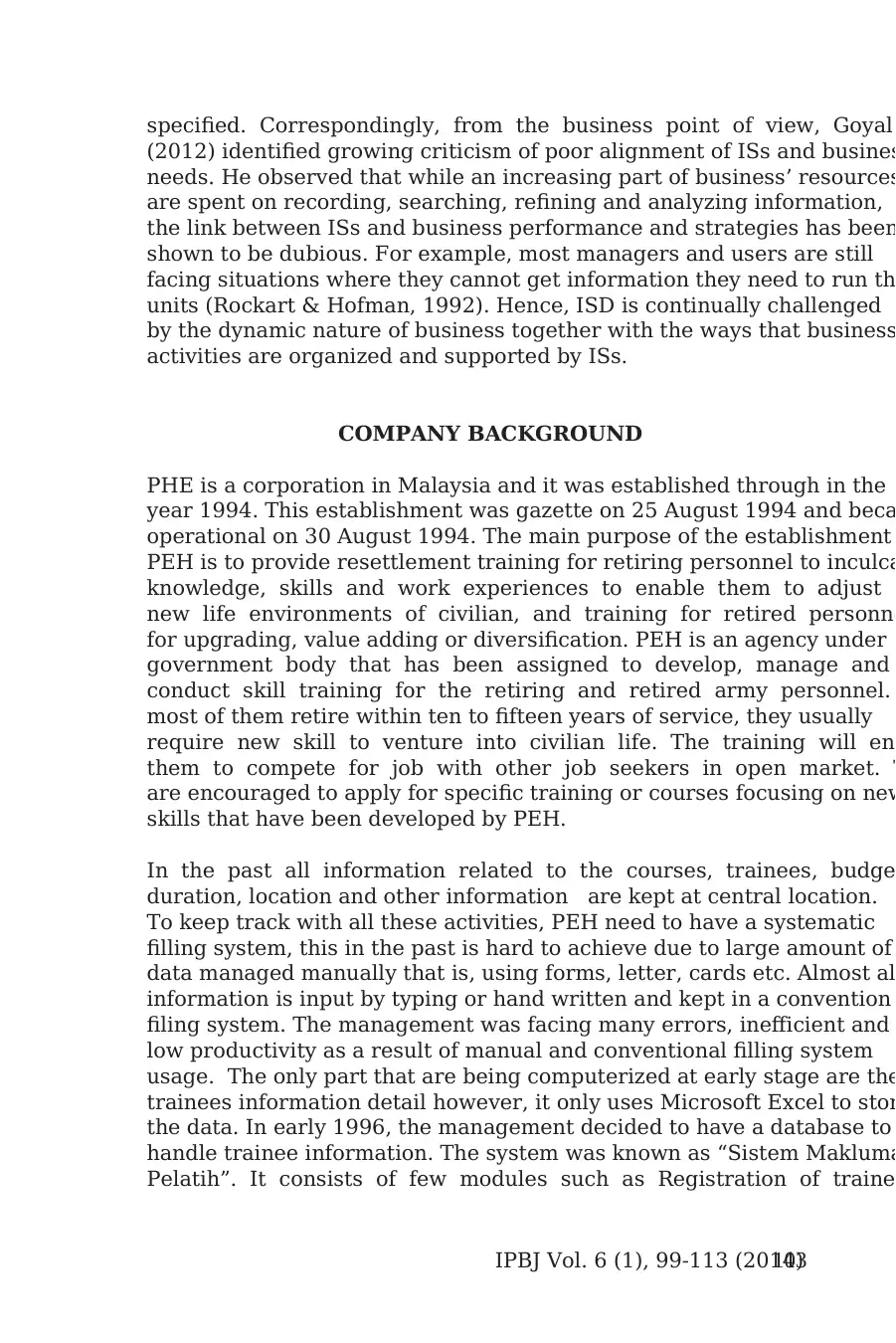
IPBJ Vol. 6 (1), 99-113 (2014)103
specified. Correspondingly, from the business point of view, Goyal
(2012) identified growing criticism of poor alignment of ISs and busines
needs. He observed that while an increasing part of business’ resources
are spent on recording, searching, refining and analyzing information,
the link between ISs and business performance and strategies has been
shown to be dubious. For example, most managers and users are still
facing situations where they cannot get information they need to run th
units (Rockart & Hofman, 1992). Hence, ISD is continually challenged
by the dynamic nature of business together with the ways that business
activities are organized and supported by ISs.
COMPANY BACKGROUND
PHE is a corporation in Malaysia and it was established through in the
year 1994. This establishment was gazette on 25 August 1994 and beca
operational on 30 August 1994. The main purpose of the establishment
PEH is to provide resettlement training for retiring personnel to inculca
knowledge, skills and work experiences to enable them to adjust t
new life environments of civilian, and training for retired personne
for upgrading, value adding or diversification. PEH is an agency under
government body that has been assigned to develop, manage and
conduct skill training for the retiring and retired army personnel.
most of them retire within ten to fifteen years of service, they usually
require new skill to venture into civilian life. The training will ena
them to compete for job with other job seekers in open market. T
are encouraged to apply for specific training or courses focusing on new
skills that have been developed by PEH.
In the past all information related to the courses, trainees, budge
duration, location and other information are kept at central location.
To keep track with all these activities, PEH need to have a systematic
filling system, this in the past is hard to achieve due to large amount of
data managed manually that is, using forms, letter, cards etc. Almost al
information is input by typing or hand written and kept in a convention
filing system. The management was facing many errors, inefficient and
low productivity as a result of manual and conventional filling system
usage. The only part that are being computerized at early stage are the
trainees information detail however, it only uses Microsoft Excel to stor
the data. In early 1996, the management decided to have a database to
handle trainee information. The system was known as “Sistem Makluma
Pelatih”. It consists of few modules such as Registration of traine
specified. Correspondingly, from the business point of view, Goyal
(2012) identified growing criticism of poor alignment of ISs and busines
needs. He observed that while an increasing part of business’ resources
are spent on recording, searching, refining and analyzing information,
the link between ISs and business performance and strategies has been
shown to be dubious. For example, most managers and users are still
facing situations where they cannot get information they need to run th
units (Rockart & Hofman, 1992). Hence, ISD is continually challenged
by the dynamic nature of business together with the ways that business
activities are organized and supported by ISs.
COMPANY BACKGROUND
PHE is a corporation in Malaysia and it was established through in the
year 1994. This establishment was gazette on 25 August 1994 and beca
operational on 30 August 1994. The main purpose of the establishment
PEH is to provide resettlement training for retiring personnel to inculca
knowledge, skills and work experiences to enable them to adjust t
new life environments of civilian, and training for retired personne
for upgrading, value adding or diversification. PEH is an agency under
government body that has been assigned to develop, manage and
conduct skill training for the retiring and retired army personnel.
most of them retire within ten to fifteen years of service, they usually
require new skill to venture into civilian life. The training will ena
them to compete for job with other job seekers in open market. T
are encouraged to apply for specific training or courses focusing on new
skills that have been developed by PEH.
In the past all information related to the courses, trainees, budge
duration, location and other information are kept at central location.
To keep track with all these activities, PEH need to have a systematic
filling system, this in the past is hard to achieve due to large amount of
data managed manually that is, using forms, letter, cards etc. Almost al
information is input by typing or hand written and kept in a convention
filing system. The management was facing many errors, inefficient and
low productivity as a result of manual and conventional filling system
usage. The only part that are being computerized at early stage are the
trainees information detail however, it only uses Microsoft Excel to stor
the data. In early 1996, the management decided to have a database to
handle trainee information. The system was known as “Sistem Makluma
Pelatih”. It consists of few modules such as Registration of traine
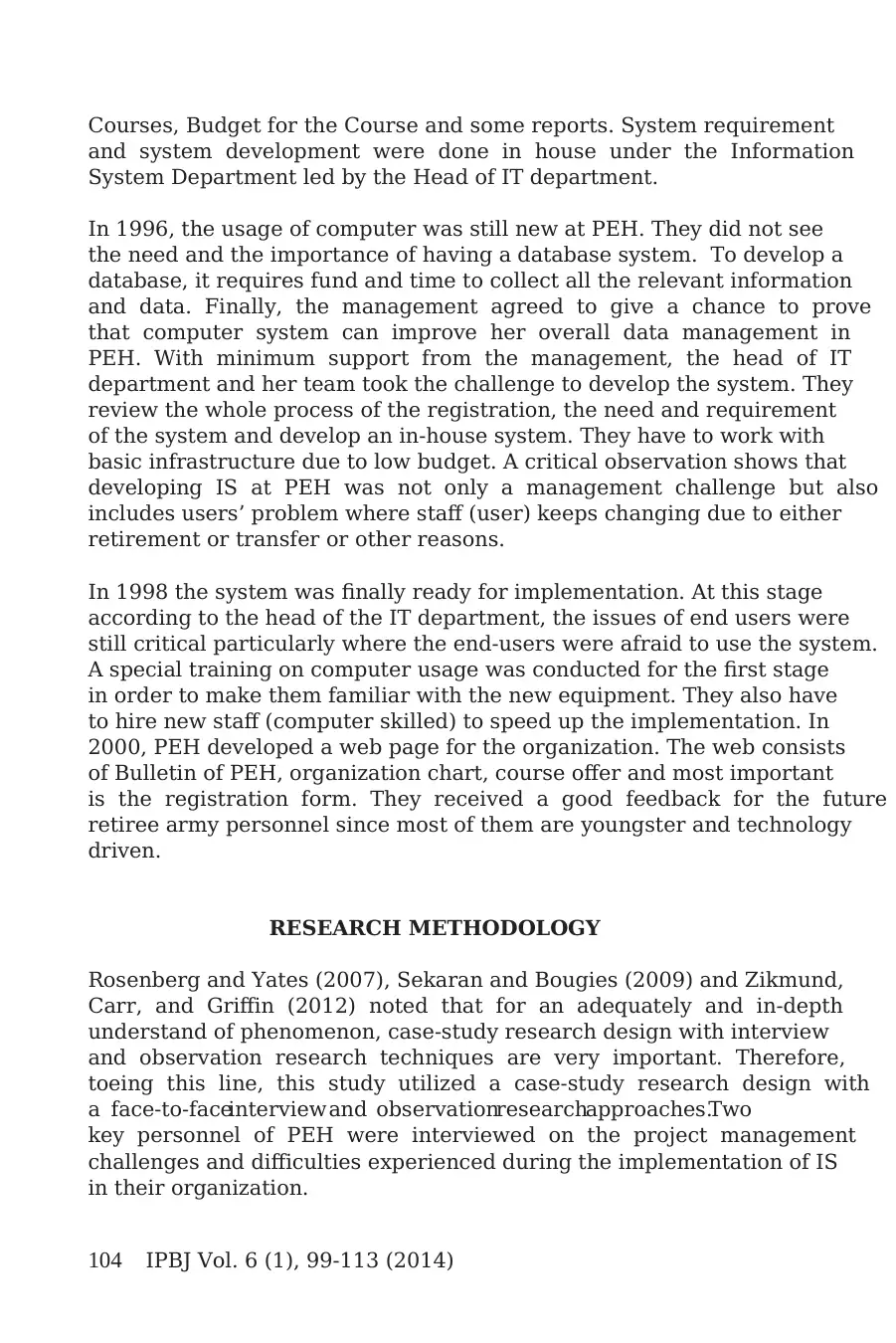
104 IPBJ Vol. 6 (1), 99-113 (2014)
Courses, Budget for the Course and some reports. System requirement
and system development were done in house under the Information
System Department led by the Head of IT department.
In 1996, the usage of computer was still new at PEH. They did not see
the need and the importance of having a database system. To develop a
database, it requires fund and time to collect all the relevant information
and data. Finally, the management agreed to give a chance to prove
that computer system can improve her overall data management in
PEH. With minimum support from the management, the head of IT
department and her team took the challenge to develop the system. They
review the whole process of the registration, the need and requirement
of the system and develop an in-house system. They have to work with
basic infrastructure due to low budget. A critical observation shows that
developing IS at PEH was not only a management challenge but also
includes users’ problem where staff (user) keeps changing due to either
retirement or transfer or other reasons.
In 1998 the system was finally ready for implementation. At this stage
according to the head of the IT department, the issues of end users were
still critical particularly where the end-users were afraid to use the system.
A special training on computer usage was conducted for the first stage
in order to make them familiar with the new equipment. They also have
to hire new staff (computer skilled) to speed up the implementation. In
2000, PEH developed a web page for the organization. The web consists
of Bulletin of PEH, organization chart, course offer and most important
is the registration form. They received a good feedback for the future
retiree army personnel since most of them are youngster and technology
driven.
RESEARCH METHODOLOGY
Rosenberg and Yates (2007), Sekaran and Bougies (2009) and Zikmund,
Carr, and Griffin (2012) noted that for an adequately and in-depth
understand of phenomenon, case-study research design with interview
and observation research techniques are very important. Therefore,
toeing this line, this study utilized a case-study research design with
a face-to-faceinterview and observationresearchapproaches.Two
key personnel of PEH were interviewed on the project management
challenges and difficulties experienced during the implementation of IS
in their organization.
Courses, Budget for the Course and some reports. System requirement
and system development were done in house under the Information
System Department led by the Head of IT department.
In 1996, the usage of computer was still new at PEH. They did not see
the need and the importance of having a database system. To develop a
database, it requires fund and time to collect all the relevant information
and data. Finally, the management agreed to give a chance to prove
that computer system can improve her overall data management in
PEH. With minimum support from the management, the head of IT
department and her team took the challenge to develop the system. They
review the whole process of the registration, the need and requirement
of the system and develop an in-house system. They have to work with
basic infrastructure due to low budget. A critical observation shows that
developing IS at PEH was not only a management challenge but also
includes users’ problem where staff (user) keeps changing due to either
retirement or transfer or other reasons.
In 1998 the system was finally ready for implementation. At this stage
according to the head of the IT department, the issues of end users were
still critical particularly where the end-users were afraid to use the system.
A special training on computer usage was conducted for the first stage
in order to make them familiar with the new equipment. They also have
to hire new staff (computer skilled) to speed up the implementation. In
2000, PEH developed a web page for the organization. The web consists
of Bulletin of PEH, organization chart, course offer and most important
is the registration form. They received a good feedback for the future
retiree army personnel since most of them are youngster and technology
driven.
RESEARCH METHODOLOGY
Rosenberg and Yates (2007), Sekaran and Bougies (2009) and Zikmund,
Carr, and Griffin (2012) noted that for an adequately and in-depth
understand of phenomenon, case-study research design with interview
and observation research techniques are very important. Therefore,
toeing this line, this study utilized a case-study research design with
a face-to-faceinterview and observationresearchapproaches.Two
key personnel of PEH were interviewed on the project management
challenges and difficulties experienced during the implementation of IS
in their organization.
Paraphrase This Document
Need a fresh take? Get an instant paraphrase of this document with our AI Paraphraser

IPBJ Vol. 6 (1), 99-113 (2014)105
RESULTS AND DISCUSSIONS
In the early stage of establishment, there was no specific informa
system been developed to cater for data collections in PEH. This
due to:
• lack of requirement on information system
• lack of knowledge of the people (employee) on the system
• lack of budget for software and hardware
• lack of staff to implement the system
Even PEH was established in 1994, yet the first recruitment of an IT sta
was conducted in 1996. There was no IT Department specifically at that
point of time. A critical observation shows that IS implementation
PERHEBAT at the initial stage was manually. For example, the system
was stand-alone based on the requirement of each department. At this
stage, all data collected been processed in and by the ready-mark
applications of database and spreadsheets such as Microsoft Acces
for database and Excel for spread-sheet were later on converted
Microsoft SQL Server 2000 to deal with number of data. They engaged
IS professional to develop the system for trainees’ data and registration
They named it as Sistem Maklumat Pelatih (Trainee Information System
As time goes by, the requirements of information are getting mor
challenging and more complex from related departments for registratio
of trainees,payrolls, procurements,human resourceactivitiesand
financial recordings and reports. The organization has developed in
house systems based on departmentalprocesses.However, the in-
house systems were not integrated with each other but stood alon
and were developed to serve each department alone. With the consent
of Management, few options have been considered and implemente
gradually to cater for requirements such as:
• Bought off-the-shelfsystem and did some modificationsfor
payroll. They named it as BOSS Payroll System.
• Bought off-the-shelf system for financial recordings and reports.
They named it as OBM System.
Presently, the IT department has been established with three employee
under the name of Unit TeknologiMaklumat.The functions of IT
department are not only to monitor the systems and hardware bu
also the components of IS function that make the systems work. These
include the people and the procedures needed for processing those data
for the organization. Given the above background, the major objective
of this study therefore, is to identify and reveal the project management
RESULTS AND DISCUSSIONS
In the early stage of establishment, there was no specific informa
system been developed to cater for data collections in PEH. This
due to:
• lack of requirement on information system
• lack of knowledge of the people (employee) on the system
• lack of budget for software and hardware
• lack of staff to implement the system
Even PEH was established in 1994, yet the first recruitment of an IT sta
was conducted in 1996. There was no IT Department specifically at that
point of time. A critical observation shows that IS implementation
PERHEBAT at the initial stage was manually. For example, the system
was stand-alone based on the requirement of each department. At this
stage, all data collected been processed in and by the ready-mark
applications of database and spreadsheets such as Microsoft Acces
for database and Excel for spread-sheet were later on converted
Microsoft SQL Server 2000 to deal with number of data. They engaged
IS professional to develop the system for trainees’ data and registration
They named it as Sistem Maklumat Pelatih (Trainee Information System
As time goes by, the requirements of information are getting mor
challenging and more complex from related departments for registratio
of trainees,payrolls, procurements,human resourceactivitiesand
financial recordings and reports. The organization has developed in
house systems based on departmentalprocesses.However, the in-
house systems were not integrated with each other but stood alon
and were developed to serve each department alone. With the consent
of Management, few options have been considered and implemente
gradually to cater for requirements such as:
• Bought off-the-shelfsystem and did some modificationsfor
payroll. They named it as BOSS Payroll System.
• Bought off-the-shelf system for financial recordings and reports.
They named it as OBM System.
Presently, the IT department has been established with three employee
under the name of Unit TeknologiMaklumat.The functions of IT
department are not only to monitor the systems and hardware bu
also the components of IS function that make the systems work. These
include the people and the procedures needed for processing those data
for the organization. Given the above background, the major objective
of this study therefore, is to identify and reveal the project management

106 IPBJ Vol. 6 (1), 99-113 (2014)
major challenges and difficulties of IS development in the organization
in a particular PEH.
DISCUSSION
From the interview,the major challengesto IS developmentwere
identified. The aim was to provide validation and more insight on the
key challenges impacting on the system development in PEH. The key
informant reported all the major challenges faced by PEH during their
initial IS development. Challenges were categorized into five major
themes namely: fund, infrastructure, upgrading previous system, skills,
monitoring and inspection.
Fund
Generally, fund has been identified as one of the major that hinders
many projects particularly during early stage. As revealed by the key
informants, fund was a major obstacle and challenge that organization
faced during there IS development. This finding corroborates the ideas of
Benjamin and Blunt (2012) and Lederer (2013) that sufficient funding and
financial empowerment of new technologies is needed to survive in this
age of technological ever increasing competitive business environment.
Expressing her view, she said:
“The major difficulties faced with this organization in the time past are
lack of fund. There is always little money budgeted to the IT departme
from the total budget of PERHEBAT. This has caused the department
so many limitations to carry on smooth running of the departme
There is an intention to move and upgrade to the latest technology but
cannot achieve this objective because of lack of fund. The organization
constraint and could not move to the latest technology available in the
then market. Due to the same financial constraints, the IT department
were unable to make purchases of latest technology in the market that
would have enhance the performance of the organization in gene
Example of such purchases includes; hardware, software, cable, a
other component relevant for upgrading.”
Infrastructure issues
Another factor that was identified to imposed a challengeon IS
development in PEH is infrastructures (hardware and software). There
is need for procurement of some hard ware facilities and migration from
old to the new or conventional machines. There is also need to build
major challenges and difficulties of IS development in the organization
in a particular PEH.
DISCUSSION
From the interview,the major challengesto IS developmentwere
identified. The aim was to provide validation and more insight on the
key challenges impacting on the system development in PEH. The key
informant reported all the major challenges faced by PEH during their
initial IS development. Challenges were categorized into five major
themes namely: fund, infrastructure, upgrading previous system, skills,
monitoring and inspection.
Fund
Generally, fund has been identified as one of the major that hinders
many projects particularly during early stage. As revealed by the key
informants, fund was a major obstacle and challenge that organization
faced during there IS development. This finding corroborates the ideas of
Benjamin and Blunt (2012) and Lederer (2013) that sufficient funding and
financial empowerment of new technologies is needed to survive in this
age of technological ever increasing competitive business environment.
Expressing her view, she said:
“The major difficulties faced with this organization in the time past are
lack of fund. There is always little money budgeted to the IT departme
from the total budget of PERHEBAT. This has caused the department
so many limitations to carry on smooth running of the departme
There is an intention to move and upgrade to the latest technology but
cannot achieve this objective because of lack of fund. The organization
constraint and could not move to the latest technology available in the
then market. Due to the same financial constraints, the IT department
were unable to make purchases of latest technology in the market that
would have enhance the performance of the organization in gene
Example of such purchases includes; hardware, software, cable, a
other component relevant for upgrading.”
Infrastructure issues
Another factor that was identified to imposed a challengeon IS
development in PEH is infrastructures (hardware and software). There
is need for procurement of some hard ware facilities and migration from
old to the new or conventional machines. There is also need to build
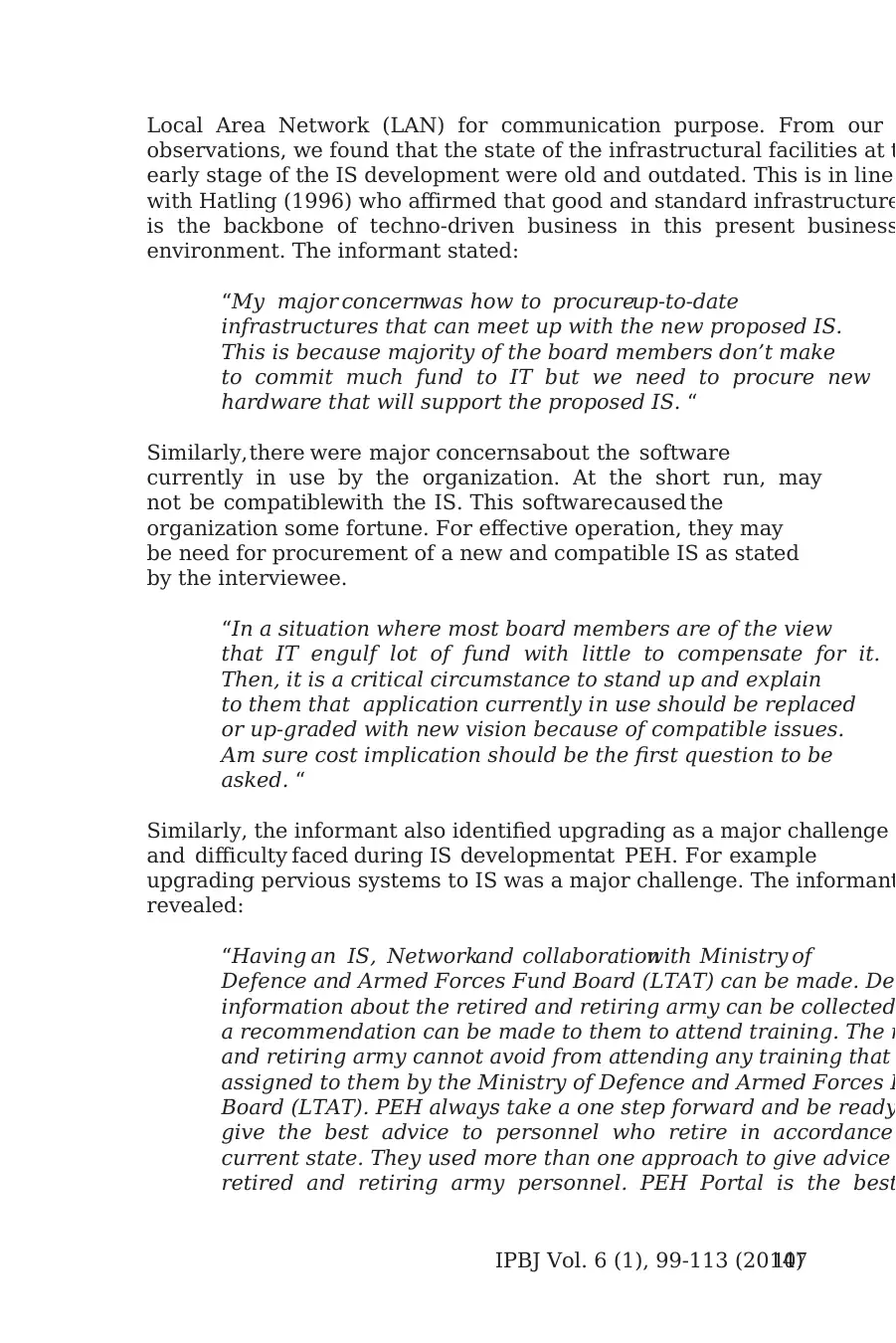
IPBJ Vol. 6 (1), 99-113 (2014)107
Local Area Network (LAN) for communication purpose. From our
observations, we found that the state of the infrastructural facilities at t
early stage of the IS development were old and outdated. This is in line
with Hatling (1996) who affirmed that good and standard infrastructure
is the backbone of techno-driven business in this present business
environment. The informant stated:
“My major concernwas how to procureup-to-date
infrastructures that can meet up with the new proposed IS.
This is because majority of the board members don’t make
to commit much fund to IT but we need to procure new
hardware that will support the proposed IS. “
Similarly, there were major concernsabout the software
currently in use by the organization. At the short run, may
not be compatiblewith the IS. This softwarecaused the
organization some fortune. For effective operation, they may
be need for procurement of a new and compatible IS as stated
by the interviewee.
“In a situation where most board members are of the view
that IT engulf lot of fund with little to compensate for it.
Then, it is a critical circumstance to stand up and explain
to them that application currently in use should be replaced
or up-graded with new vision because of compatible issues.
Am sure cost implication should be the first question to be
asked. “
Similarly, the informant also identified upgrading as a major challenge
and difficulty faced during IS developmentat PEH. For example
upgrading pervious systems to IS was a major challenge. The informant
revealed:
“Having an IS, Networkand collaborationwith Ministry of
Defence and Armed Forces Fund Board (LTAT) can be made. Det
information about the retired and retiring army can be collected
a recommendation can be made to them to attend training. The r
and retiring army cannot avoid from attending any training that
assigned to them by the Ministry of Defence and Armed Forces F
Board (LTAT). PEH always take a one step forward and be ready
give the best advice to personnel who retire in accordance
current state. They used more than one approach to give advice
retired and retiring army personnel. PEH Portal is the best
Local Area Network (LAN) for communication purpose. From our
observations, we found that the state of the infrastructural facilities at t
early stage of the IS development were old and outdated. This is in line
with Hatling (1996) who affirmed that good and standard infrastructure
is the backbone of techno-driven business in this present business
environment. The informant stated:
“My major concernwas how to procureup-to-date
infrastructures that can meet up with the new proposed IS.
This is because majority of the board members don’t make
to commit much fund to IT but we need to procure new
hardware that will support the proposed IS. “
Similarly, there were major concernsabout the software
currently in use by the organization. At the short run, may
not be compatiblewith the IS. This softwarecaused the
organization some fortune. For effective operation, they may
be need for procurement of a new and compatible IS as stated
by the interviewee.
“In a situation where most board members are of the view
that IT engulf lot of fund with little to compensate for it.
Then, it is a critical circumstance to stand up and explain
to them that application currently in use should be replaced
or up-graded with new vision because of compatible issues.
Am sure cost implication should be the first question to be
asked. “
Similarly, the informant also identified upgrading as a major challenge
and difficulty faced during IS developmentat PEH. For example
upgrading pervious systems to IS was a major challenge. The informant
revealed:
“Having an IS, Networkand collaborationwith Ministry of
Defence and Armed Forces Fund Board (LTAT) can be made. Det
information about the retired and retiring army can be collected
a recommendation can be made to them to attend training. The r
and retiring army cannot avoid from attending any training that
assigned to them by the Ministry of Defence and Armed Forces F
Board (LTAT). PEH always take a one step forward and be ready
give the best advice to personnel who retire in accordance
current state. They used more than one approach to give advice
retired and retiring army personnel. PEH Portal is the best
Secure Best Marks with AI Grader
Need help grading? Try our AI Grader for instant feedback on your assignments.
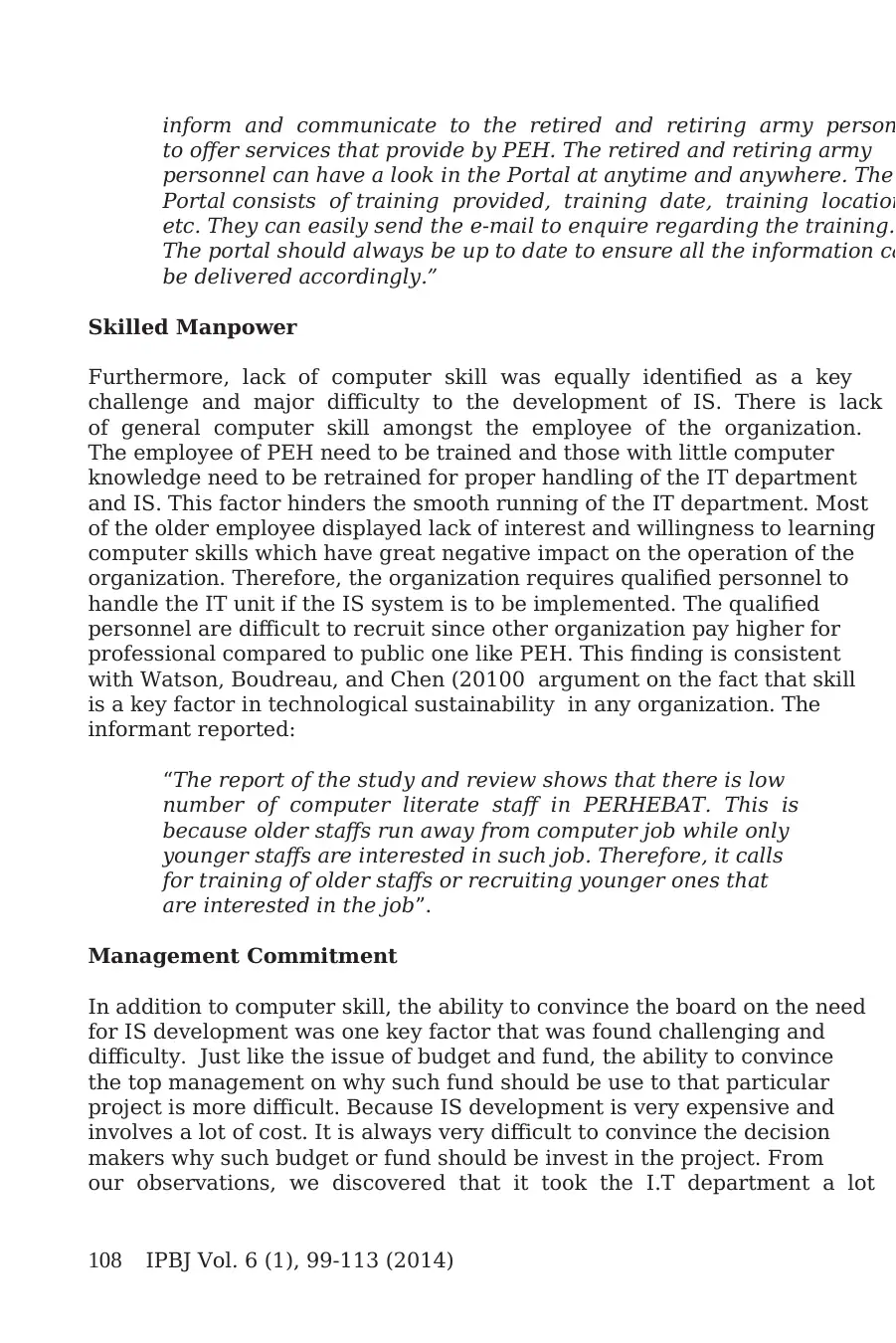
108 IPBJ Vol. 6 (1), 99-113 (2014)
inform and communicate to the retired and retiring army person
to offer services that provide by PEH. The retired and retiring army
personnel can have a look in the Portal at anytime and anywhere. The
Portal consists of training provided, training date, training location
etc. They can easily send the e-mail to enquire regarding the training.
The portal should always be up to date to ensure all the information ca
be delivered accordingly.”
Skilled Manpower
Furthermore, lack of computer skill was equally identified as a key
challenge and major difficulty to the development of IS. There is lack
of general computer skill amongst the employee of the organization.
The employee of PEH need to be trained and those with little computer
knowledge need to be retrained for proper handling of the IT department
and IS. This factor hinders the smooth running of the IT department. Most
of the older employee displayed lack of interest and willingness to learning
computer skills which have great negative impact on the operation of the
organization. Therefore, the organization requires qualified personnel to
handle the IT unit if the IS system is to be implemented. The qualified
personnel are difficult to recruit since other organization pay higher for
professional compared to public one like PEH. This finding is consistent
with Watson, Boudreau, and Chen (20100 argument on the fact that skill
is a key factor in technological sustainability in any organization. The
informant reported:
“The report of the study and review shows that there is low
number of computer literate staff in PERHEBAT. This is
because older staffs run away from computer job while only
younger staffs are interested in such job. Therefore, it calls
for training of older staffs or recruiting younger ones that
are interested in the job”.
Management Commitment
In addition to computer skill, the ability to convince the board on the need
for IS development was one key factor that was found challenging and
difficulty. Just like the issue of budget and fund, the ability to convince
the top management on why such fund should be use to that particular
project is more difficult. Because IS development is very expensive and
involves a lot of cost. It is always very difficult to convince the decision
makers why such budget or fund should be invest in the project. From
our observations, we discovered that it took the I.T department a lot
inform and communicate to the retired and retiring army person
to offer services that provide by PEH. The retired and retiring army
personnel can have a look in the Portal at anytime and anywhere. The
Portal consists of training provided, training date, training location
etc. They can easily send the e-mail to enquire regarding the training.
The portal should always be up to date to ensure all the information ca
be delivered accordingly.”
Skilled Manpower
Furthermore, lack of computer skill was equally identified as a key
challenge and major difficulty to the development of IS. There is lack
of general computer skill amongst the employee of the organization.
The employee of PEH need to be trained and those with little computer
knowledge need to be retrained for proper handling of the IT department
and IS. This factor hinders the smooth running of the IT department. Most
of the older employee displayed lack of interest and willingness to learning
computer skills which have great negative impact on the operation of the
organization. Therefore, the organization requires qualified personnel to
handle the IT unit if the IS system is to be implemented. The qualified
personnel are difficult to recruit since other organization pay higher for
professional compared to public one like PEH. This finding is consistent
with Watson, Boudreau, and Chen (20100 argument on the fact that skill
is a key factor in technological sustainability in any organization. The
informant reported:
“The report of the study and review shows that there is low
number of computer literate staff in PERHEBAT. This is
because older staffs run away from computer job while only
younger staffs are interested in such job. Therefore, it calls
for training of older staffs or recruiting younger ones that
are interested in the job”.
Management Commitment
In addition to computer skill, the ability to convince the board on the need
for IS development was one key factor that was found challenging and
difficulty. Just like the issue of budget and fund, the ability to convince
the top management on why such fund should be use to that particular
project is more difficult. Because IS development is very expensive and
involves a lot of cost. It is always very difficult to convince the decision
makers why such budget or fund should be invest in the project. From
our observations, we discovered that it took the I.T department a lot

IPBJ Vol. 6 (1), 99-113 (2014)109
of effort to convince and talk the top management into accepting
need to spend such fund on IS development. Expressing her view, the
informant said:
“In a situation where most board members are of the view
engulf lot of fund with little to compensate for it. Then, it is a cri
circumstance to stand up and explain to them that applica
currently in use should be replaced or up-graded with new
because of compatible issues. Am sure cost implication should be
first question to be asked”.
Monitoring and Inspection
Apart from lack of fund, infrastructure, upgrading previous systems and
lack of skills, monitoring and inspection was a critical factor as identifie
by the informant. PEH has a big problem when coming to the processin
of an application to attend a new training by the applicant. This is becau
all the information is kept manually and has to be retrieved manually.
The information about the trainee and courses attended are not b
kept accordingly. This will then slow down the process of approving of
the new application by the current trainee. She said,
“An integrated IS shall reduce the trauma and stress on the of m
information retrieval system which slow down work process. Wit
use and structured information system, PERE can have a good w
tracking the trainees courses attended. Retrieving information o
trainee, retrieving about the course attended, course offer and d
are easier, faster and more efficient. Monitoring and inspec
ensure all the trainee have completed their courses and succeed
life after retirement can be monitored. A list of report can be acc
show courses that they have attended and the advanced courses
if required by them.”
Project Management ISD Checklist
Today, the usage of computer is beyond office use to support business
operations but more to creation of central database, central informatio
processing and decision making to improve the organization overa
performance and to give better mean to provide information and trainin
for the future retiring army. The study asserts that the installation
central database will straighten ICT infrastructure in any organization
with integration of up-to-date technologies and application. With th
inline PEH mission to set up a University College by the year of 2015
is seem possible. Having a central database will enhance all processes
of effort to convince and talk the top management into accepting
need to spend such fund on IS development. Expressing her view, the
informant said:
“In a situation where most board members are of the view
engulf lot of fund with little to compensate for it. Then, it is a cri
circumstance to stand up and explain to them that applica
currently in use should be replaced or up-graded with new
because of compatible issues. Am sure cost implication should be
first question to be asked”.
Monitoring and Inspection
Apart from lack of fund, infrastructure, upgrading previous systems and
lack of skills, monitoring and inspection was a critical factor as identifie
by the informant. PEH has a big problem when coming to the processin
of an application to attend a new training by the applicant. This is becau
all the information is kept manually and has to be retrieved manually.
The information about the trainee and courses attended are not b
kept accordingly. This will then slow down the process of approving of
the new application by the current trainee. She said,
“An integrated IS shall reduce the trauma and stress on the of m
information retrieval system which slow down work process. Wit
use and structured information system, PERE can have a good w
tracking the trainees courses attended. Retrieving information o
trainee, retrieving about the course attended, course offer and d
are easier, faster and more efficient. Monitoring and inspec
ensure all the trainee have completed their courses and succeed
life after retirement can be monitored. A list of report can be acc
show courses that they have attended and the advanced courses
if required by them.”
Project Management ISD Checklist
Today, the usage of computer is beyond office use to support business
operations but more to creation of central database, central informatio
processing and decision making to improve the organization overa
performance and to give better mean to provide information and trainin
for the future retiring army. The study asserts that the installation
central database will straighten ICT infrastructure in any organization
with integration of up-to-date technologies and application. With th
inline PEH mission to set up a University College by the year of 2015
is seem possible. Having a central database will enhance all processes
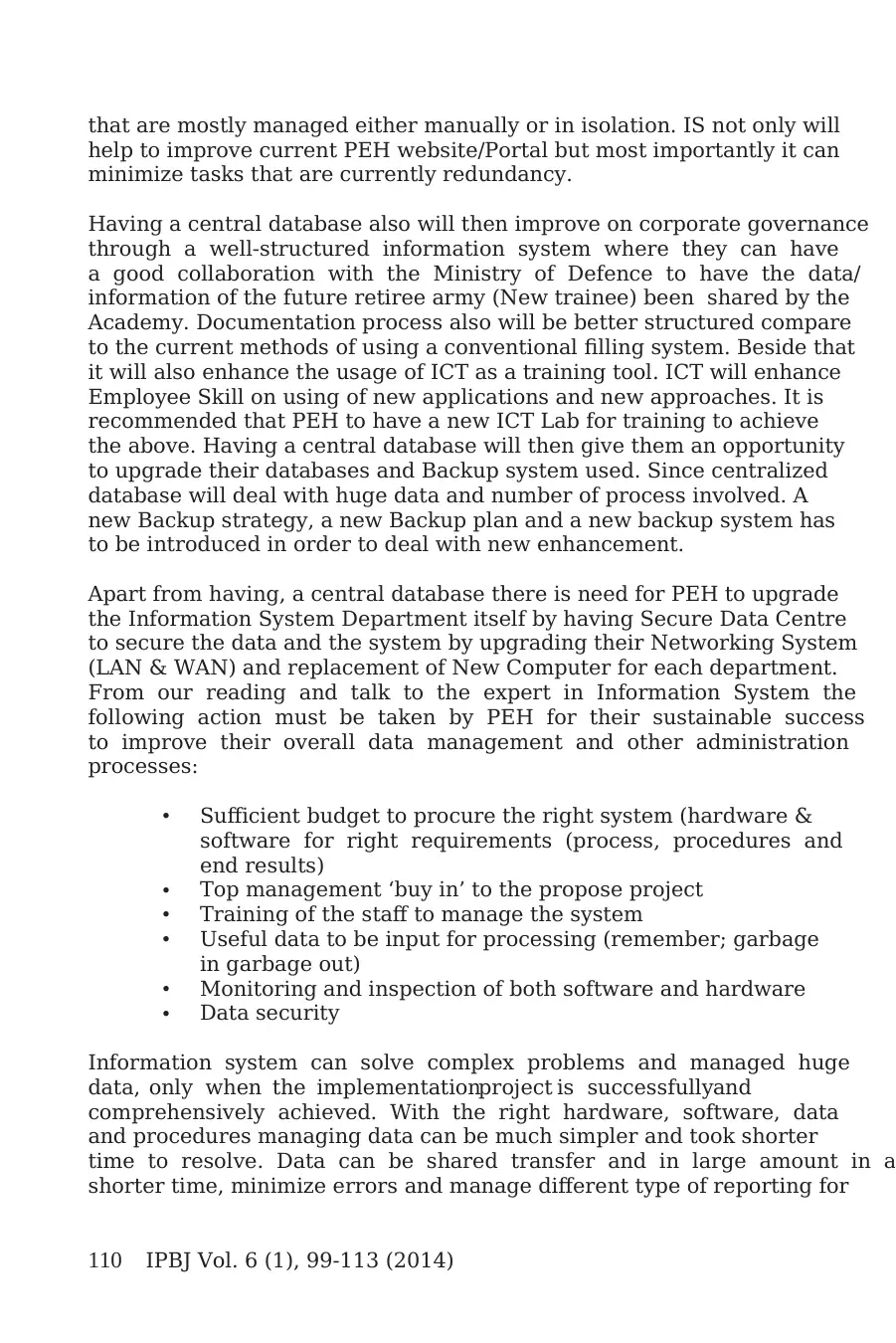
110 IPBJ Vol. 6 (1), 99-113 (2014)
that are mostly managed either manually or in isolation. IS not only will
help to improve current PEH website/Portal but most importantly it can
minimize tasks that are currently redundancy.
Having a central database also will then improve on corporate governance
through a well-structured information system where they can have
a good collaboration with the Ministry of Defence to have the data/
information of the future retiree army (New trainee) been shared by the
Academy. Documentation process also will be better structured compare
to the current methods of using a conventional filling system. Beside that
it will also enhance the usage of ICT as a training tool. ICT will enhance
Employee Skill on using of new applications and new approaches. It is
recommended that PEH to have a new ICT Lab for training to achieve
the above. Having a central database will then give them an opportunity
to upgrade their databases and Backup system used. Since centralized
database will deal with huge data and number of process involved. A
new Backup strategy, a new Backup plan and a new backup system has
to be introduced in order to deal with new enhancement.
Apart from having, a central database there is need for PEH to upgrade
the Information System Department itself by having Secure Data Centre
to secure the data and the system by upgrading their Networking System
(LAN & WAN) and replacement of New Computer for each department.
From our reading and talk to the expert in Information System the
following action must be taken by PEH for their sustainable success
to improve their overall data management and other administration
processes:
• Sufficient budget to procure the right system (hardware &
software for right requirements (process, procedures and
end results)
• Top management ‘buy in’ to the propose project
• Training of the staff to manage the system
• Useful data to be input for processing (remember; garbage
in garbage out)
• Monitoring and inspection of both software and hardware
• Data security
Information system can solve complex problems and managed huge
data, only when the implementationproject is successfullyand
comprehensively achieved. With the right hardware, software, data
and procedures managing data can be much simpler and took shorter
time to resolve. Data can be shared transfer and in large amount in a
shorter time, minimize errors and manage different type of reporting for
that are mostly managed either manually or in isolation. IS not only will
help to improve current PEH website/Portal but most importantly it can
minimize tasks that are currently redundancy.
Having a central database also will then improve on corporate governance
through a well-structured information system where they can have
a good collaboration with the Ministry of Defence to have the data/
information of the future retiree army (New trainee) been shared by the
Academy. Documentation process also will be better structured compare
to the current methods of using a conventional filling system. Beside that
it will also enhance the usage of ICT as a training tool. ICT will enhance
Employee Skill on using of new applications and new approaches. It is
recommended that PEH to have a new ICT Lab for training to achieve
the above. Having a central database will then give them an opportunity
to upgrade their databases and Backup system used. Since centralized
database will deal with huge data and number of process involved. A
new Backup strategy, a new Backup plan and a new backup system has
to be introduced in order to deal with new enhancement.
Apart from having, a central database there is need for PEH to upgrade
the Information System Department itself by having Secure Data Centre
to secure the data and the system by upgrading their Networking System
(LAN & WAN) and replacement of New Computer for each department.
From our reading and talk to the expert in Information System the
following action must be taken by PEH for their sustainable success
to improve their overall data management and other administration
processes:
• Sufficient budget to procure the right system (hardware &
software for right requirements (process, procedures and
end results)
• Top management ‘buy in’ to the propose project
• Training of the staff to manage the system
• Useful data to be input for processing (remember; garbage
in garbage out)
• Monitoring and inspection of both software and hardware
• Data security
Information system can solve complex problems and managed huge
data, only when the implementationproject is successfullyand
comprehensively achieved. With the right hardware, software, data
and procedures managing data can be much simpler and took shorter
time to resolve. Data can be shared transfer and in large amount in a
shorter time, minimize errors and manage different type of reporting for
Paraphrase This Document
Need a fresh take? Get an instant paraphrase of this document with our AI Paraphraser
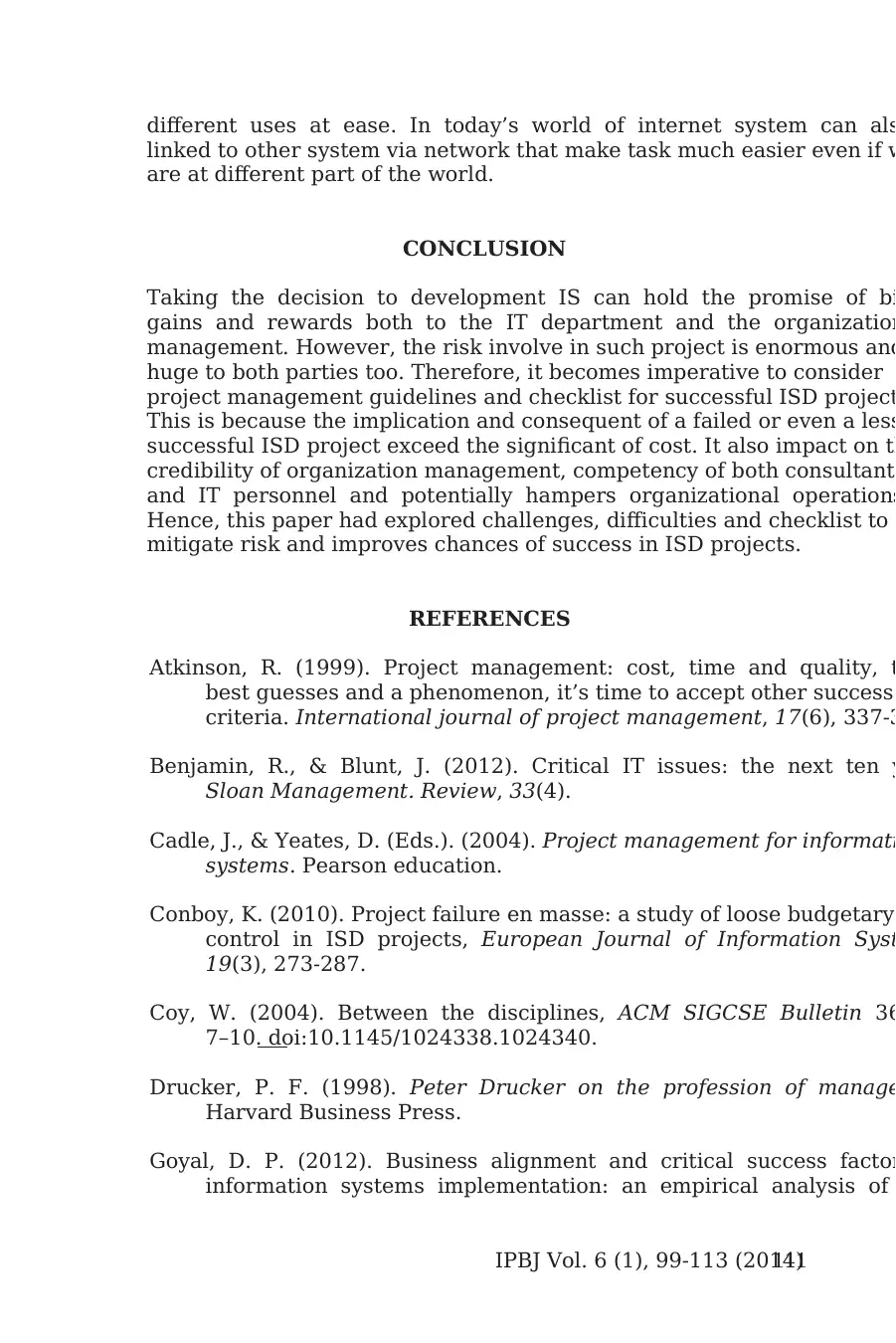
IPBJ Vol. 6 (1), 99-113 (2014)111
different uses at ease. In today’s world of internet system can als
linked to other system via network that make task much easier even if w
are at different part of the world.
CONCLUSION
Taking the decision to development IS can hold the promise of bi
gains and rewards both to the IT department and the organization
management. However, the risk involve in such project is enormous and
huge to both parties too. Therefore, it becomes imperative to consider
project management guidelines and checklist for successful ISD project
This is because the implication and consequent of a failed or even a less
successful ISD project exceed the significant of cost. It also impact on th
credibility of organization management, competency of both consultant
and IT personnel and potentially hampers organizational operations
Hence, this paper had explored challenges, difficulties and checklist to
mitigate risk and improves chances of success in ISD projects.
REFERENCES
Atkinson, R. (1999). Project management: cost, time and quality, t
best guesses and a phenomenon, it’s time to accept other success
criteria. International journal of project management, 17(6), 337-3
Benjamin, R., & Blunt, J. (2012). Critical IT issues: the next ten y
Sloan Management. Review, 33(4).
Cadle, J., & Yeates, D. (Eds.). (2004). Project management for informati
systems. Pearson education.
Conboy, K. (2010). Project failure en masse: a study of loose budgetary
control in ISD projects, European Journal of Information Syst
19(3), 273-287.
Coy, W. (2004). Between the disciplines, ACM SIGCSE Bulletin 36
7–10. doi:10.1145/1024338.1024340.
Drucker, P. F. (1998). Peter Drucker on the profession of manage
Harvard Business Press.
Goyal, D. P. (2012). Business alignment and critical success factor
information systems implementation: an empirical analysis of
different uses at ease. In today’s world of internet system can als
linked to other system via network that make task much easier even if w
are at different part of the world.
CONCLUSION
Taking the decision to development IS can hold the promise of bi
gains and rewards both to the IT department and the organization
management. However, the risk involve in such project is enormous and
huge to both parties too. Therefore, it becomes imperative to consider
project management guidelines and checklist for successful ISD project
This is because the implication and consequent of a failed or even a less
successful ISD project exceed the significant of cost. It also impact on th
credibility of organization management, competency of both consultant
and IT personnel and potentially hampers organizational operations
Hence, this paper had explored challenges, difficulties and checklist to
mitigate risk and improves chances of success in ISD projects.
REFERENCES
Atkinson, R. (1999). Project management: cost, time and quality, t
best guesses and a phenomenon, it’s time to accept other success
criteria. International journal of project management, 17(6), 337-3
Benjamin, R., & Blunt, J. (2012). Critical IT issues: the next ten y
Sloan Management. Review, 33(4).
Cadle, J., & Yeates, D. (Eds.). (2004). Project management for informati
systems. Pearson education.
Conboy, K. (2010). Project failure en masse: a study of loose budgetary
control in ISD projects, European Journal of Information Syst
19(3), 273-287.
Coy, W. (2004). Between the disciplines, ACM SIGCSE Bulletin 36
7–10. doi:10.1145/1024338.1024340.
Drucker, P. F. (1998). Peter Drucker on the profession of manage
Harvard Business Press.
Goyal, D. P. (2012). Business alignment and critical success factor
information systems implementation: an empirical analysis of
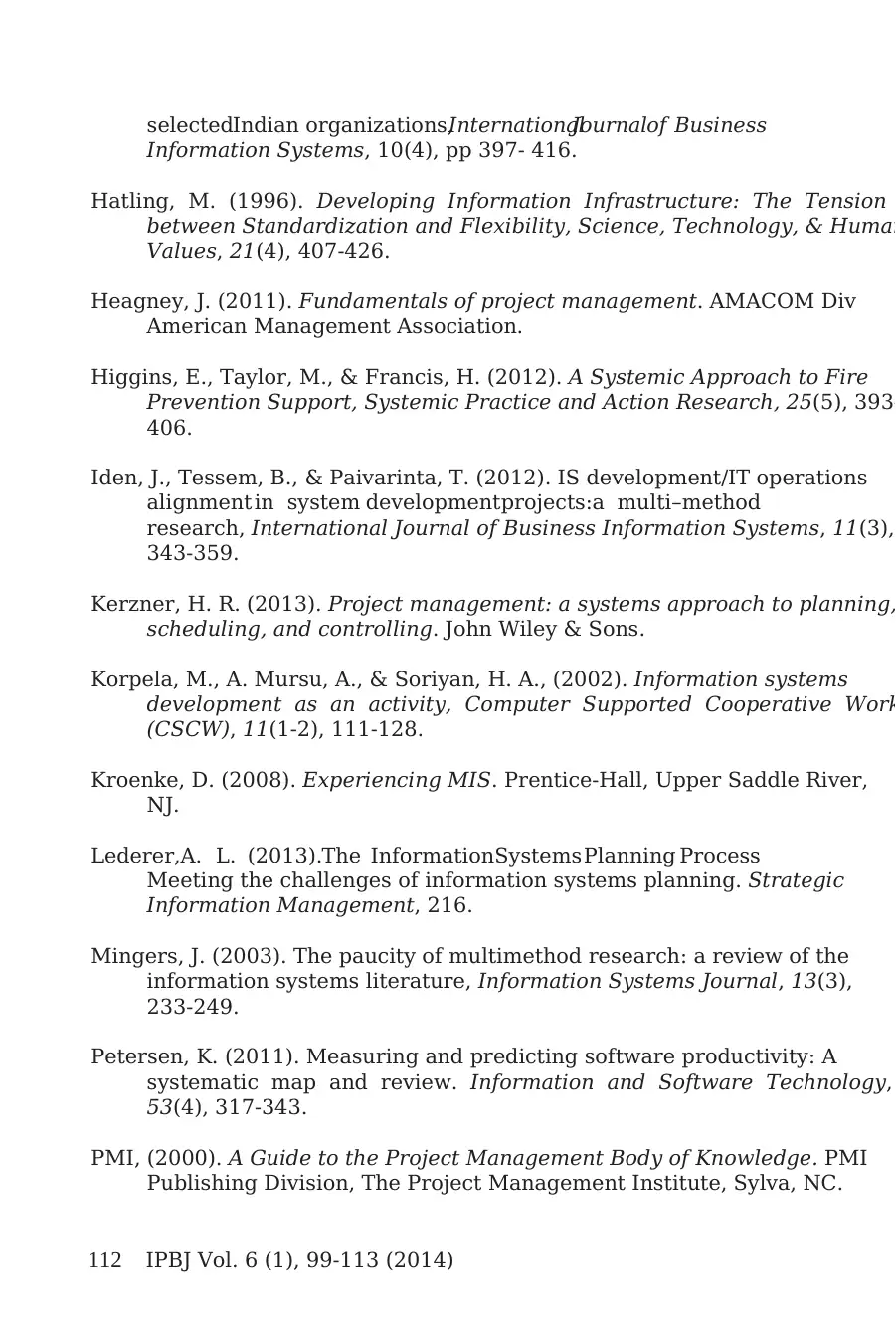
112 IPBJ Vol. 6 (1), 99-113 (2014)
selectedIndian organizations,InternationalJournalof Business
Information Systems, 10(4), pp 397- 416.
Hatling, M. (1996). Developing Information Infrastructure: The Tension
between Standardization and Flexibility, Science, Technology, & Human
Values, 21(4), 407-426.
Heagney, J. (2011). Fundamentals of project management. AMACOM Div
American Management Association.
Higgins, E., Taylor, M., & Francis, H. (2012). A Systemic Approach to Fire
Prevention Support, Systemic Practice and Action Research, 25(5), 393-
406.
Iden, J., Tessem, B., & Paivarinta, T. (2012). IS development/IT operations
alignment in system developmentprojects:a multi–method
research, International Journal of Business Information Systems, 11(3),
343-359.
Kerzner, H. R. (2013). Project management: a systems approach to planning,
scheduling, and controlling. John Wiley & Sons.
Korpela, M., A. Mursu, A., & Soriyan, H. A., (2002). Information systems
development as an activity, Computer Supported Cooperative Work
(CSCW), 11(1-2), 111-128.
Kroenke, D. (2008). Experiencing MIS. Prentice-Hall, Upper Saddle River,
NJ.
Lederer,A. L. (2013).The InformationSystems Planning Process
Meeting the challenges of information systems planning. Strategic
Information Management, 216.
Mingers, J. (2003). The paucity of multimethod research: a review of the
information systems literature, Information Systems Journal, 13(3),
233-249.
Petersen, K. (2011). Measuring and predicting software productivity: A
systematic map and review. Information and Software Technology,
53(4), 317-343.
PMI, (2000). A Guide to the Project Management Body of Knowledge. PMI
Publishing Division, The Project Management Institute, Sylva, NC.
selectedIndian organizations,InternationalJournalof Business
Information Systems, 10(4), pp 397- 416.
Hatling, M. (1996). Developing Information Infrastructure: The Tension
between Standardization and Flexibility, Science, Technology, & Human
Values, 21(4), 407-426.
Heagney, J. (2011). Fundamentals of project management. AMACOM Div
American Management Association.
Higgins, E., Taylor, M., & Francis, H. (2012). A Systemic Approach to Fire
Prevention Support, Systemic Practice and Action Research, 25(5), 393-
406.
Iden, J., Tessem, B., & Paivarinta, T. (2012). IS development/IT operations
alignment in system developmentprojects:a multi–method
research, International Journal of Business Information Systems, 11(3),
343-359.
Kerzner, H. R. (2013). Project management: a systems approach to planning,
scheduling, and controlling. John Wiley & Sons.
Korpela, M., A. Mursu, A., & Soriyan, H. A., (2002). Information systems
development as an activity, Computer Supported Cooperative Work
(CSCW), 11(1-2), 111-128.
Kroenke, D. (2008). Experiencing MIS. Prentice-Hall, Upper Saddle River,
NJ.
Lederer,A. L. (2013).The InformationSystems Planning Process
Meeting the challenges of information systems planning. Strategic
Information Management, 216.
Mingers, J. (2003). The paucity of multimethod research: a review of the
information systems literature, Information Systems Journal, 13(3),
233-249.
Petersen, K. (2011). Measuring and predicting software productivity: A
systematic map and review. Information and Software Technology,
53(4), 317-343.
PMI, (2000). A Guide to the Project Management Body of Knowledge. PMI
Publishing Division, The Project Management Institute, Sylva, NC.
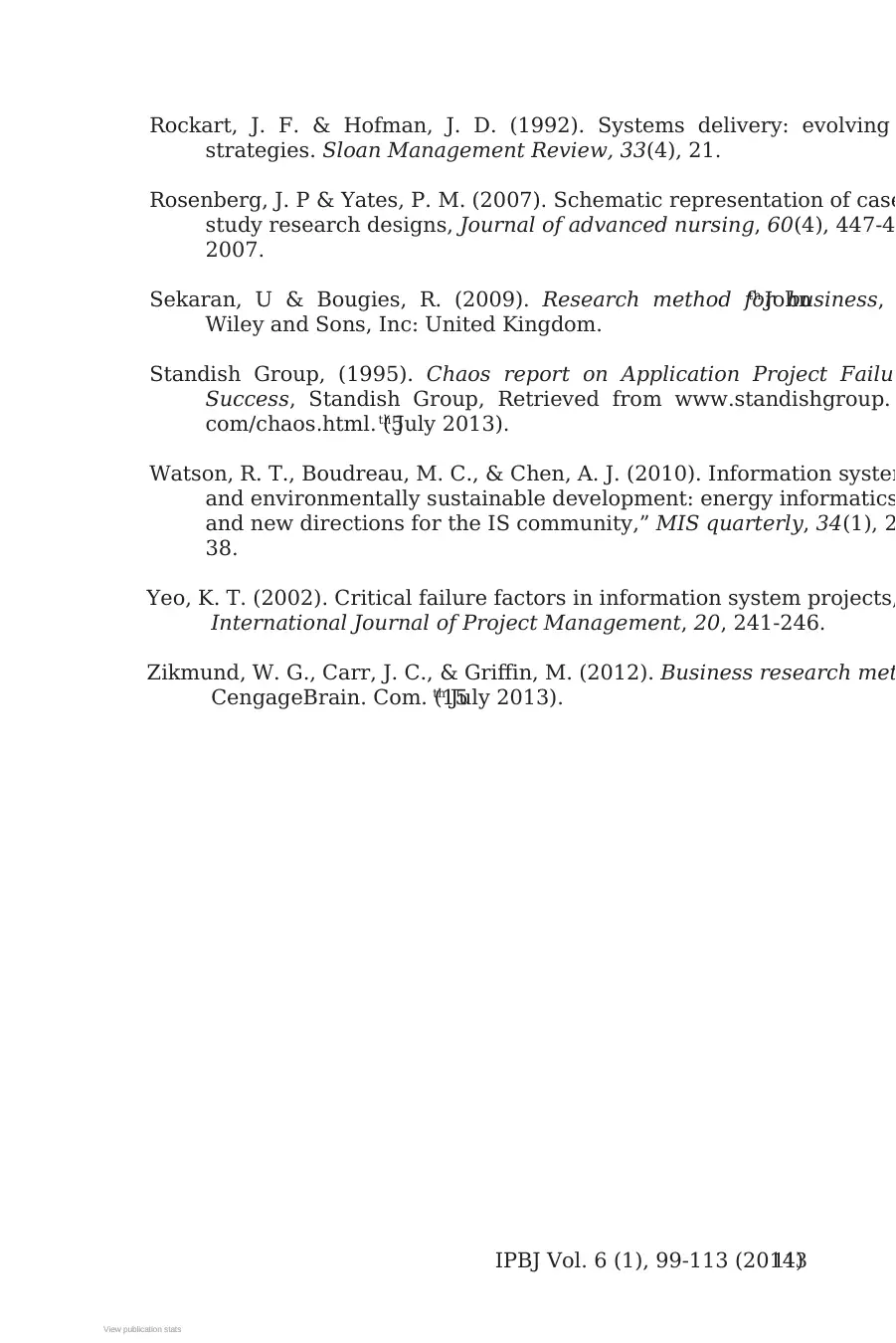
IPBJ Vol. 6 (1), 99-113 (2014)113
Rockart, J. F. & Hofman, J. D. (1992). Systems delivery: evolving
strategies. Sloan Management Review, 33(4), 21.
Rosenberg, J. P & Yates, P. M. (2007). Schematic representation of case
study research designs, Journal of advanced nursing, 60(4), 447-4
2007.
Sekaran, U & Bougies, R. (2009). Research method for business,th John
Wiley and Sons, Inc: United Kingdom.
Standish Group, (1995). Chaos report on Application Project Failur
Success, Standish Group, Retrieved from www.standishgroup.
com/chaos.html. (5th July 2013).
Watson, R. T., Boudreau, M. C., & Chen, A. J. (2010). Information system
and environmentally sustainable development: energy informatics
and new directions for the IS community,” MIS quarterly, 34(1), 2
38.
Yeo, K. T. (2002). Critical failure factors in information system projects,
International Journal of Project Management, 20, 241-246.
Zikmund, W. G., Carr, J. C., & Griffin, M. (2012). Business research met
CengageBrain. Com. (15th July 2013).
View publication statsView publication stats
Rockart, J. F. & Hofman, J. D. (1992). Systems delivery: evolving
strategies. Sloan Management Review, 33(4), 21.
Rosenberg, J. P & Yates, P. M. (2007). Schematic representation of case
study research designs, Journal of advanced nursing, 60(4), 447-4
2007.
Sekaran, U & Bougies, R. (2009). Research method for business,th John
Wiley and Sons, Inc: United Kingdom.
Standish Group, (1995). Chaos report on Application Project Failur
Success, Standish Group, Retrieved from www.standishgroup.
com/chaos.html. (5th July 2013).
Watson, R. T., Boudreau, M. C., & Chen, A. J. (2010). Information system
and environmentally sustainable development: energy informatics
and new directions for the IS community,” MIS quarterly, 34(1), 2
38.
Yeo, K. T. (2002). Critical failure factors in information system projects,
International Journal of Project Management, 20, 241-246.
Zikmund, W. G., Carr, J. C., & Griffin, M. (2012). Business research met
CengageBrain. Com. (15th July 2013).
View publication statsView publication stats
1 out of 16
Related Documents
Your All-in-One AI-Powered Toolkit for Academic Success.
+13062052269
info@desklib.com
Available 24*7 on WhatsApp / Email
![[object Object]](/_next/static/media/star-bottom.7253800d.svg)
Unlock your academic potential
© 2024 | Zucol Services PVT LTD | All rights reserved.





